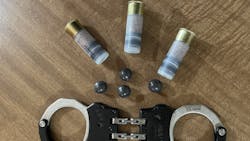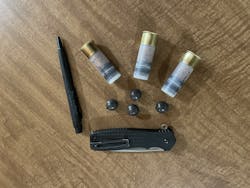Less-Lethal Munitions Are Evolving
While the 12-gauge weapon platform has remained relatively unchanged, the munitions themselves have evolved quite a bit. By Frank Borelli
Unless you’ve been living under a rock for the past year, you’re aware of the huge media and political push for “law enforcement reform.” What many of those uninformed media pundits don’t know—and most politicians don’t care to learn—is that “reform” within law enforcement is nothing new and has been going on for decades. Every year there are new laws, protocols, policies and tactics we have to train on. New technology is always in development.All of the new technology developed, however, does not erase the old. Less-lethal munitions have been around a long time. Rubber bullets, chemical delivery rounds, etc. have been manufactured for 12-gauge systems for decades. In a minute we’ll take a look at some of the munitions, but first let’s address one of the biggest challenges agencies can face in using such munitions: public perception.
Even if you have a dedicated less-lethal shotgun with all blaze orange furniture, a shotgun is still a shotgun and people taking pictures only know what they’ve seen on TV. Many people still believe that being shot with a bird shot (12 shot) round at a range of twenty-five yards is devastating. It’ll blow you off your feet and right through a plate glass window. Right? Wrong… but most of them don’t know that. All they see is this devastating firearm.
What’s the answer? The biggest “reform” measure most agencies can implement is communication. In line with this misperception created by Hollywood and the mainstream media is the belief that law enforcement agencies keep secrets and are “protecting our own.” Too few understand what the privacy laws allow us to share, or not, and how a criminal investigation can be compromised by loose lips. The only way the citizens we serve will ever come to understand this is if we become more transparent in our policies and process. Public education should be a big piece of all reform efforts.
Once that line of communication is established and open and the citizens have come to trust it, then we can discuss other information; information that will help them understand how reality is very different from what Hollywood creates. We need to help them realize that even “reality TV” isn’t realistic. They may begin to understand that we’re not eager to do harm; that we’d far prefer to never be in a fight; and that we do—above all else—hold life sacred. That is why less-lethal technologies were developed in the first place.
Which brings us back to one of the oldest types of less-lethal use of force: custom munitions for 12g shotguns. The 12g platform is ideal for supporting a wide variety of ammo types, even if not less-lethal. From slugs to 12-shot, non projectile type munitions and even flares (signaling devices), the 12g shotgun has proven itself adaptable over the years. While the weapon platform has remained relatively unchanged, the munitions themselves have evolved. New synthetics, different propellants and more contribute to this evolution.
One example is the Stand Down 12g less-lethal munition manufactured by Avert Industries. The Stand Down ammo is a 2.75” dual projectile munition; something that isn’t new in the less-lethal world. Again, though, new technologies mean new manufacturing and new options. The end result is different from what we all knew 20 years ago.
Per their website (www.avertindustries.com), the two projectiles are made of “a Patent Pending Hybrid Plastic-Metal Alloy.” For those of us who think in simpler terms, they’re rubber projectiles. As per their website though, “The base elastomeric polymer is soft and malleable, while the rare metal additive dramatically increases mass.” The end result is a slightly heavier but still flexible sphere—two per shot.
With a tested engagement distance as close as eight feet and accuracy out to 75 feet (25 yards) or more (depending on your skill, terrain, etc.), the Stand Down ammo can be an excellent message delivery system to disagreeable subjects. The two projectiles are .68 caliber each—a very common size for less-lethal munitions—and have a velocity of approximately 550 feet per second. Each projectile weighs 5.0 grams (77 grains). These are not designed for deflected deployment (bouncing off the street) but are for direct engagement. That in mind, nothing prohibits deflected deployment and your agency policy should be observed.
In a less-lethal deployment situation, there are numerous advantages to a dedicated 12g shotgun, but non-dedicated weapons can be used (depending on your agency policy). The psychological effect of shotguns being deployed is significant. The site and sound of rounds being chambered can have a huge psychological impact. If the Stand Down munitions are deployed, subjects—when impacted—can perceive “the miracle” of not being seriously injured when struck. That said, the energy delivery and impact perception will definitely convey the message that further aggression should cease...immediately.
Like all less-lethal ammo, you’ll never see anything that says penetration is impossible, but the minimal risk of it with the maximum delivery of pain compliance is about the best balance you can expect or reasonably hope for. The use of such munitions isn’t something an agency should keep a secret or avoid discussing. After all, it’s a munition specifically selected because it minimizes the risk of permanent injury to engaged subjects while accomplishing the law enforcement mission with as much regard for human life as possible. The sanctity of life should be prominent in all messages to the community. And all of this can be presented as part of an “on-going proactive reform effort” on the part of your agency.
The Avert Industries Stand Down munitions, or any other 12g less-lethal ammo, should be just one tool in your less-lethal tool box. Combined with organic aerosols such as OC Spray, electro-muscular disruption tools (such as Axon’s TASER or the PHAZZER), bean bag rounds and other devices, 12g less-lethal munitions can increase your agency’s riot control capabilities while continuing to minimize subject risk—in accordance with your policy.

Lt. Frank Borelli (ret), Editorial Director | Editorial Director
Lt. Frank Borelli is the Editorial Director for the Officer Media Group. Frank brings 20+ years of writing and editing experience in addition to 40 years of law enforcement operations, administration and training experience to the team.
Frank has had numerous books published which are available on Amazon.com, BarnesAndNoble.com, and other major retail outlets.
If you have any comments or questions, you can contact him via email at [email protected].




